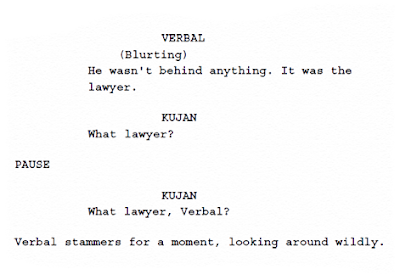Recently, I was reading the scripts for The Usual Suspects and The Shawshank Redemption, two of my favourite movies of all time. Both shared a technique mentioned in Save the Cat, called a Booster Rocket.
Now, Blake Snyder describes a Booster Rocket as a character introduced in the beginning of Act 2 to help the story forward into the Act Two. Both the scripts mentioned earlier, however, used their ‘booster rockets’ much later in the piece.
In The Usual Suspects, Verbal has been sparring with Agent Kujan for a while and the story needs a new development to really get the action going again. We get that kick start at around about the half-way mark, page sixty-four, to be exact:
Once Verbal brings Kobayashi, the lawyer, into the picture, it really starts to give some direction and thrust to the story. It is Kobayashi who focuses the plot and sees the pieces begin to fall into place.
In The Shawshank Redemption it is after the half-way mark before we meet our ‘booster rocket.’ After eighty-one pages of Frank Darabont’s brilliant script, Andy and Red have settled into a routine. Without something new to shake things up, the story would peter out and lose momentum. Enter Tommy Williams.
Tommy is a fun character, but he serves a vitally important plot purpose. His presence, and the revelation of a significant piece of evidence, spurs Andy on to make his move.
Without these two ‘booster rockets’ both The Usual Suspects and The Shawshank Redemption would be lesser movies. These characters serve important plot points, but their appearance is not needed until late in the stories.
It is important, when considering your own use of a similar type character, that they are not merely Deus Ex Machina characters. Their entry and must be consistent with the story, and not too contrived or coincidental.
Also, they must incite the hero to act. Make sure the hero is the one to decide. You do not want your booster rocket supplanting the hero or making them passive.
In conclusion, ‘booster rocket’ characters can be used early in a movie, to help ease the action into Act Two, as Blake Snyder mentions in his book Save the Cat. But, they can also be used later in a movie to introduce a new beat of action or to help re-energise a story and give the hero some extra motivation to finish, or an additional obstacle to overcome.
